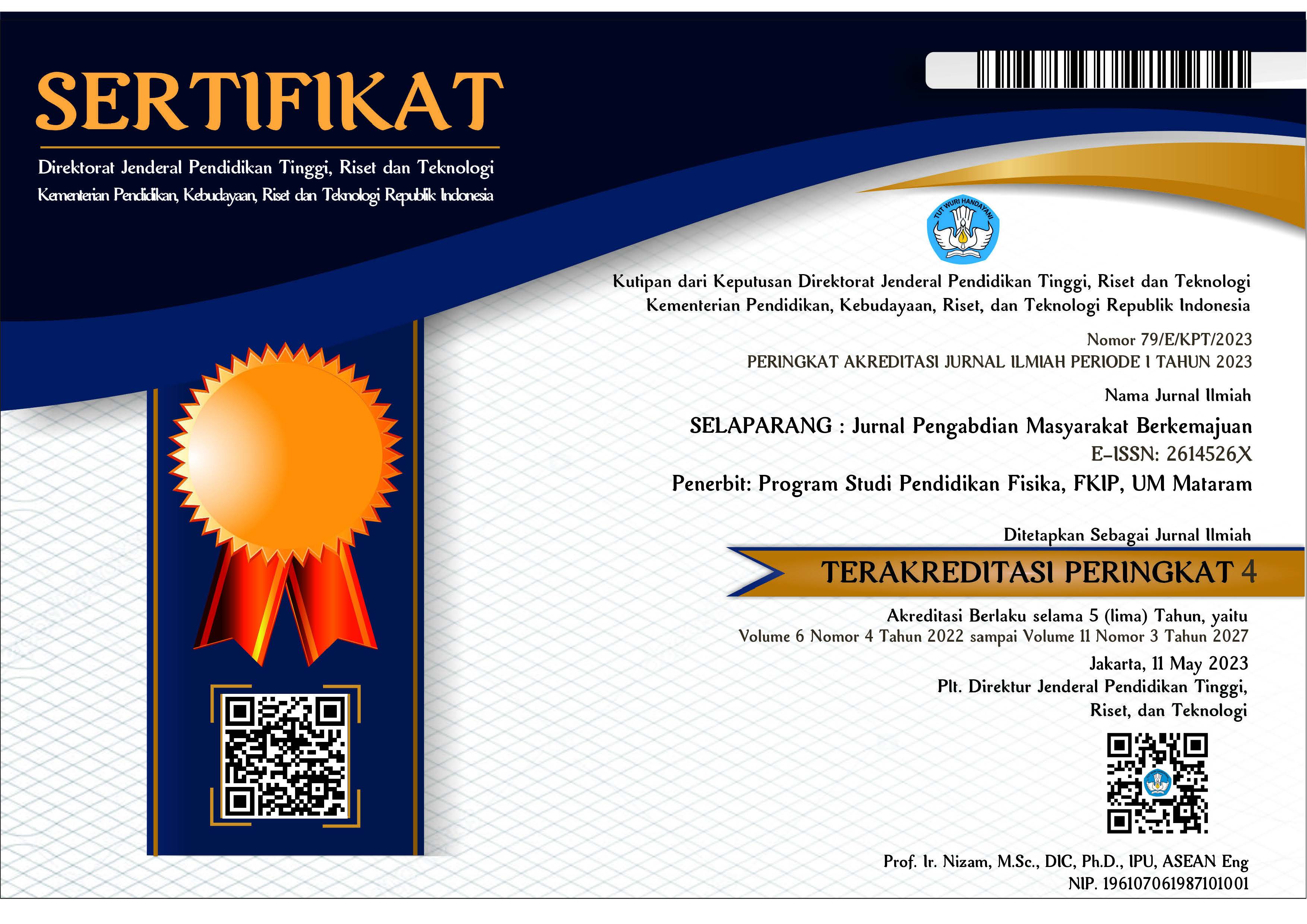Peningkatan keterampilan petani dalam produksi pupuk organik dan pestisida nabati di Desa Jenggawah Kabupaten Jember
Abstract
Abstrak
Desa Jenggawah di Kabupaten Jember Provinsi Jawa Timur dikenal sebagai salah satu pusat produksi padi dan palawija. Namun, petani di daerah ini menghadapi tantangan berupa kesulitan mendapatkan pupuk dan serangan hama serangga yang sering mengganggu produksi. Program pengabdian kepada masyarakat ini bertujuan untuk memberikan pelatihan kepada petani di Kelompok Tani Mulyo, Desa Jenggawah, agar dapat memproduksi pupuk organik dan pestisida nabati secara mandiri. Kegiatan ini meliputi penyuluhan, pelatihan, dan praktik pembuatan pupuk organik dan pestisida nabati dari bahan alami. Hasil pelatihan menunjukkan peningkatan yang signifikan dalam keterampilan dan motivasi peserta. Berdasarkan uji T, ditemukan perbedaan signifikan dalam keterampilan sebelum dan sesudah pelatihan. Program ini berhasil meningkatkan kemampuan petani dalam memproduksi pupuk organik dan pestisida nabati, yang diharapkan dapat membantu mereka menghadapi tantangan produksi dan meningkatkan hasil pertanian di masa mendatang.
Kata kunci: fermentasi; limbah; motivasi; penyuluhan; praktik
Abstract
Jenggawah Village in Jember Regency, East Java Province, is known as one of the key centers for rice and secondary crop production. However, farmers in this region face challenges such as difficulty in accessing fertilizers and frequent insect pest infestations that disrupt agricultural production. This community service program aims to provide training to the Mulyo Farmers Group in Jenggawah Village, enabling them to independently produce organic fertilizers and botanical pesticides. The program is implemented through education, training, and hands-on field practice, where participants are taught to produce solid and liquid organic fertilizers using materials such as livestock manure, fruit waste, and neem and papaya leaves for the production of botanical pesticides. The results of the training showed a significant improvement in the participants' skills and motivation. Based on the T-test, a significant difference was found in the participants' skills before and after the training. This program successfully enhanced the farmers' ability to produce organic fertilizers and botanical pesticides, which is expected to help them address production challenges and improve agricultural yields in the future.
Keywords: fermentation; waste; motivation; extension; practice
Keywords
Full Text:
PDFReferences
Bayazitova, Z. E., Kurmanbayeva, A. S., Tleuova, Z. O., & Temirbekova, N. G. (2023). Application of the thermophilic fermentation method to obtain environmentally friendly organic fertilizer. Journal of Ecological Engineering, 24(4):13-20. https://doi.org/10.12911/22998993/159647.
Bergstrand, K.-J. (2022). Organic fertilizers in greenhouse production systems–a review. Scientia Horticulturae, 295: 110855. https://doi.org/10.1016/j.scienta.2021.110855.
BPS. (2023). Kecamatan Jenggawah Dalam Angka 2023.
Damalas, C. A., & Koutroubas, S. D. (2020). Botanical pesticides for eco‐friendly pest management: Drawbacks and limitations. Pesticides in Crop Production: Physiological and Biochemical Action, 181-193.
Gupta, N., Sharma, N., & Ramniwas, S. (2022). Botanical pesticides: use of plants in pest management. CGC International Journal of Contemporary Technology and Research, 4: 1. https://doi.org/10.46860/cgcijctr.2021.12.31.271.
Hadi, S., & Ediyanto, R. A. (2016). Respons petani terhadap usaha tani padi organik di Desa Sruni Kecamatan Jenggawah Kabupaten Jember. Jurnal Saintek, 13(1):29-35.
Haryanta, D., Sa’adah, T. T., Thohiron, M., & Rejeki, F. S. (2023). Utilization of urban waste as liquid organic fertilizer for vegetable crops in urban farming system. Plant Science Today, 10(2):120-128. https://doi.org/10.14719/pst.2028.
Jiang, Y., Li, K., Chen, S., Fu, X., Feng, S., & Zhuang, Z. (2022). A sustainable agricultural supply chain considering substituting organic manure for chemical fertilizer. Sustainable Production and Consumption, 29:432-446. https://doi.org/10.1016/j.spc.2021.10.025.
Kilani-Morakchi, S., Morakchi-Goudjil, H., & Sifi, K. (2021). Azadirachtin-based insecticide: Overview, risk assessments, and future directions. Frontiers in Agronomy, 3:676208. https://doi.org/10.3389/fagro.2021.676208.
Leong, W.-H., Teh, S.-Y., Hossain, M. M., Nadarajaw, T., Zabidi-Hussin, Z., Chin, S.-Y., Lai, K.-S., & Lim, S.-H. E. (2020). Application, monitoring and adverse effects in pesticide use: The importance of reinforcement of Good Agricultural Practices (GAPs). Journal of Environmental Management, 260: 109987. https://doi.org/10.1016/j.jenvman.2019.109987.
Mokoginta, M. M., & Mohamad, Y. (2022). Refugia as an environmentally friendly plant for increasing production and income of corn farmers. Journal La Lifesci, 3(1):45-53. https://doi.org/10.37899/journallalifesci.v3i1.609.
Ngegba, P. M., Cui, G., Khalid, M. Z., & Zhong, G. (2022). Use of botanical pesticides in agriculture as an alternative to synthetic pesticides. Agriculture, 12(5):600. https://doi.org/10.3390/agriculture12050600.
Norton, G. W., & Alwang, J. (2020). Changes in agricultural extension and implications for farmer adoption of new practices. Applied Economic Perspectives and Policy, 42(1):8-20. https://doi.org/10.1002/aepp.13008.
Patty, C. W., Puttileihalat, P. M., & Ririmase, P. M. (2022). Characteristics of farmers and production of sheep dung as organic fertilizer for food crops in Kisar Island. Devotion: Journal of Research and Community Service, 3(13):2289-2296. https://doi.org/10.36418/dev.v3i13.289.
Pradana, A. P., Masnilah, R., Izzatika, Z. N., Hoesain, M., Hasjim, S., Wagiyana, W., Suharto, S., Alfarisy, F. K., & Irawan, B. (2024). Manajemen kesehatan tanaman hortikultura di desa Sukorambi kabupaten Jember. Selaparang: Jurnal Pengabdian Masyarakat Berkemajuan, 8(1):410-420. https://doi.org/10.31764/jpmb.v8i1.21214.
Ratto, F., Bruce, T., Chipabika, G., Mwamakamba, S., Mkandawire, R., Khan, Z., Mkindi, A., Pittchar, J., Chidawanyika, F., & Sallu, S. M. (2022). Biological control interventions and botanical pesticides for insect pests of crops in sub-Saharan Africa: A mapping review. Frontiers in Sustainable Food Systems, 6:883975. https://doi.org/10.3389/fsufs.2022.883975.
Ruslinda, Y., Aziz, R., Arum, L. S., & Sari, N. (2021). The effect of activator addition to the compost with biopore infiltration hole (BIH) method. Jurnal Ilmu Lingkungan, 19(1):53-59. https://doi.org/10.14710/jil.19.1.53-59.
Saravanan, G. (2022). Plants and phytochemical activity as botanical pesticides for sustainable agricultural crop production in India-MiniReview. Journal of Agriculture and Food Research, 9: 100345. https://doi.org/10.1016/j.jafr.2022.100345.
Shao, Y., Chen, J., Wang, L., Hou, M., & Chen, D. (2021). Effects of fermented organic fertilizer application on soil N2O emission under the vegetable rotation in polyhouse. Environmental Research, 200:111491. https://doi.org/10.1016/j.envres.2021.111491.
Shrestha, J., Kandel, M., Subedi, S., & Shah, K. K. (2020). Role of nutrients in rice (Oryza sativa L.): A review. Agrica, 9(1):53-62. https://doi.org/10.5958/2394-448X.2020.00008.5.
Wadekar, A. B., Nimbalwar, M. G., Panchale, W. A., Gudalwar, B. R., Manwar, J. V., & Bakal, R. L. (2021). Morphology, phytochemistry and pharmacological aspects of Carica papaya, an review. GSC Biological and Pharmaceutical Sciences, 14(3):234-248. https://doi.org/10.30574/gscbps.2021.14.3.0073.
Windriyanti, W., Rahmadhini, N., Megasari, D., Kusuma, R. M., & Supriadi, Y. N. (2023). Refugia plants as natural enemy microhabitat for pest control on mango (Mangifera indica L.) farmer group Sukodadi Pasuruan. Batara Wisnu: Indonesian Journal of Community Services, 3(2):334-339. https://doi.org/10.53363/bw.v3i2.187.
DOI: https://doi.org/10.31764/jpmb.v8i4.26742
Refbacks
- There are currently no refbacks.

This work is licensed under a Creative Commons Attribution-ShareAlike 4.0 International License.
______________________________________________________
Jurnal Selaparang
p-ISSN 2614-5251 || e-ISSN 2614-526X
EDITORIAL OFFICE:



















